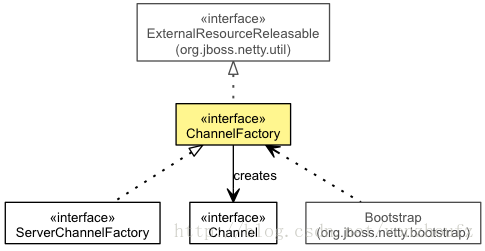Netty入门实例及分析
2020-12-13 16:48
标签:netty clientbootstrap serverbootstrap channel
Netty入门实例及分析,搜素材,soscw.com Netty入门实例及分析 标签:netty clientbootstrap serverbootstrap channel 原文地址:http://blog.csdn.net/vonzhoufz/article/details/32314517
import java.net.InetSocketAddress;
import java.util.concurrent.Executors;
import org.jboss.netty.bootstrap.ClientBootstrap;
import org.jboss.netty.channel.ChannelFactory;
import org.jboss.netty.channel.ChannelPipeline;
import org.jboss.netty.channel.ChannelPipelineFactory;
import org.jboss.netty.channel.Channels;
import org.jboss.netty.channel.socket.nio.NioClientSocketChannelFactory;
public class TimeClient {
public static void main(String[] args) {
String host = args[0];
int port = Integer.parseInt(args[1]);
ChannelFactory factory = new NioClientSocketChannelFactory(
Executors.newCachedThreadPool(), Executors.newCachedThreadPool());
ClientBootstrap bootstrap = new ClientBootstrap(factory);
bootstrap.setPipelineFactory(new ChannelPipelineFactory() {
@Override
public ChannelPipeline getPipeline() throws Exception {
return Channels.pipeline(new TimeClientHandler2());
}
});
bootstrap.connect(new InetSocketAddress(host, port)); //
}
}
import java.util.Date;
import org.jboss.netty.buffer.ChannelBuffer;
import org.jboss.netty.channel.Channel;
import org.jboss.netty.channel.ChannelHandlerContext;
import org.jboss.netty.channel.ExceptionEvent;
import org.jboss.netty.channel.MessageEvent;
import org.jboss.netty.channel.SimpleChannelHandler;
public class TimeClientHandler extends SimpleChannelHandler{
@Override
public void messageReceived(ChannelHandlerContext ctx, MessageEvent e)
throws Exception {
ChannelBuffer buffer = (ChannelBuffer)e.getMessage();
long currentTimeMills = buffer.readInt() * 1000L;
System.out.println(new Date(currentTimeMills));
e.getChannel().close();
}
@Override
public void exceptionCaught(ChannelHandlerContext ctx, ExceptionEvent e)
throws Exception {
e.getCause().printStackTrace();
Channel c = e.getChannel();
c.close();
}
}
import java.net.InetSocketAddress;
import java.util.concurrent.Executors;
import org.jboss.netty.bootstrap.ServerBootstrap;
import org.jboss.netty.channel.Channel;
import org.jboss.netty.channel.ChannelFactory;
import org.jboss.netty.channel.ChannelPipeline;
import org.jboss.netty.channel.ChannelPipelineFactory;
import org.jboss.netty.channel.Channels;
import org.jboss.netty.channel.group.ChannelGroup;
import org.jboss.netty.channel.group.ChannelGroupFuture;
import org.jboss.netty.channel.group.DefaultChannelGroup;
import org.jboss.netty.channel.socket.nio.NioServerSocketChannelFactory;
public class TimeServer {
public static ChannelGroup allChannels = new DefaultChannelGroup("time-server");
public static void main(String[] args) {
ChannelFactory factory = new NioServerSocketChannelFactory(
Executors.newCachedThreadPool(),
Executors.newCachedThreadPool());
ServerBootstrap bootstrap = new ServerBootstrap(factory);
bootstrap.setPipelineFactory(new ChannelPipelineFactory() {
@Override
public ChannelPipeline getPipeline() throws Exception {
return Channels.pipeline(new TimeServerHandler2(),
new TimeEncoder());
}
});
bootstrap.setOption("reuseAddr", true);
bootstrap.setOption("child.tcpNoDelay", true);
bootstrap.setOption("child.keepAlive", true);
Channel channel = bootstrap.bind(new InetSocketAddress(8080));
allChannels.add(channel);
//waitForShutdownCommand(); this is a imaginary logic:for instance
//when there is accepted connection we close this server ;
if(allChannels.size() >=2){
ChannelGroupFuture f = allChannels.close();
f.awaitUninterruptibly();
factory.releaseExternalResources();
}
}
}
import org.jboss.netty.buffer.ChannelBuffer;
import org.jboss.netty.buffer.ChannelBuffers;
import org.jboss.netty.channel.Channel;
import org.jboss.netty.channel.ChannelFuture;
import org.jboss.netty.channel.ChannelFutureListener;
import org.jboss.netty.channel.ChannelHandlerContext;
import org.jboss.netty.channel.ChannelStateEvent;
import org.jboss.netty.channel.ExceptionEvent;
import org.jboss.netty.channel.SimpleChannelHandler;
public class TimeServerHandler extends SimpleChannelHandler{
@Override
public void channelConnected(ChannelHandlerContext ctx, ChannelStateEvent e)
throws Exception {
Channel ch = e.getChannel();
ChannelBuffer time = ChannelBuffers.buffer(4); //sizeof int
time.writeInt((int)(System.currentTimeMillis()/1000L + 2208988800L));
ChannelFuture cf = ch.write(time);
cf.addListener(new ChannelFutureListener() {
@Override
public void operationComplete(ChannelFuture future) throws Exception {
Channel ch = future.getChannel();
ch.close();
}
});
}
@Override
public void exceptionCaught(ChannelHandlerContext ctx, ExceptionEvent e)
throws Exception {
e.getCause().printStackTrace();
Channel c = e.getChannel();
c.close();
}
}